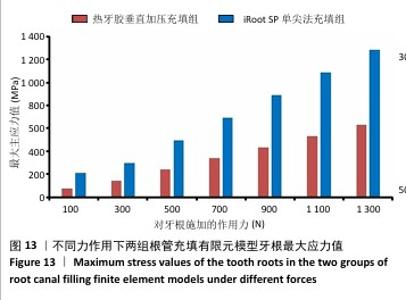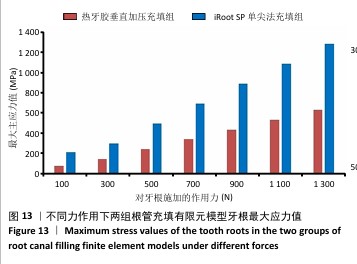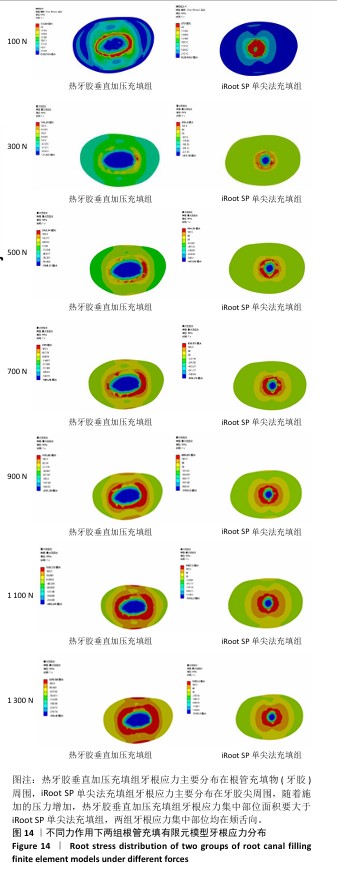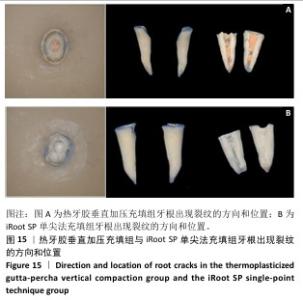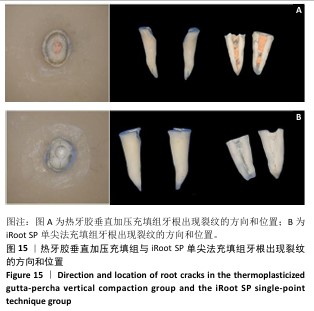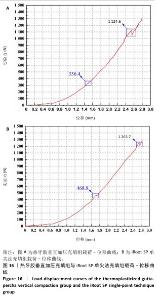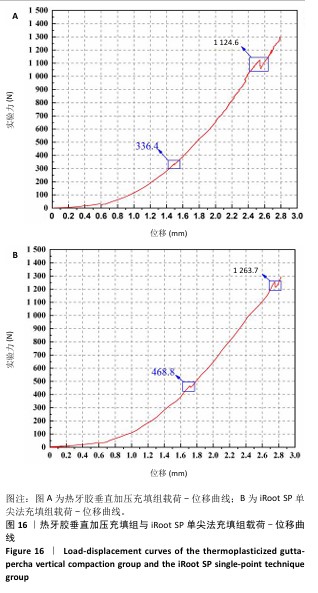[1] 郭晶晶,汤屹群,何宏,等.3种根管充填方法在慢性根尖周炎根管治疗中的短期疗效观察[J].上海口腔医学,2022,31(5):544-549.
[2] 季梦真,漆美瑶,杜珂芯,等.开髓洞型对全冠修复后隐裂牙抗力影响的三维有限元研究[J].国际口腔医学杂志,2021,48(1):41-49.
[3] 张方琪,曹选平,蓝肖淑,等.根管治疗后牙根纵裂与牙体修复相关性的回顾性研究[J].牙体牙髓牙周病学杂志,2024,29(9):520-529.
[4] HABIBZADEH S, GHONCHEH Z, KABIRI P, et al. Diagnostic efficacy of cone-beam computed tomography for detection of vertical root fractures in endodontically treated teeth: a systematic review. BMC Med Imaging. 2023;23(1):68.
[5] PEREIRA RD, LEONI GB, SILVA-SOUSA YT, et al. Impact of Conservative Endodontic Cavities on Root Canal Preparation and Biomechanical Behavior of Upper Premolars Restored with Different Materials. J Endod. 2021;47(6):989-999.
[6] PAN X, LIU W, WANG C, et al. Characteristics of vertical root fractures at early stages: Evidence that dentinal microcracks are an experimental phenomenon. Int Endod J. 2025;58(5):736-743.
[7] 林男男,邓婧,王通,等.根管治疗对椭圆形根管牙根抗折性的影响[J].口腔医学,2019,39(6):561-564.
[8] PATEL S, BHUVA B, BOSE R. Present status and future directions: vertical root fractures in root filled teeth. Int Endod J. 2022;55 Suppl 3(Suppl 3): 804-826.
[9] WAN B, CHUNG BH, ZHANG MR, et al. The Effect of Varying Occlusal Loading Conditions on Stress Distribution in Roots of Sound and Instrumented Molar Teeth: A Finite Element Analysis. J Endod. 2022; 48(7):893-901.
[10] CHEN D, CHEN Y, PAN Y, et al. Fatigue Performance and Stress Distribution of Endodontically Treated Premolars Restored with Direct Bulk-fill Resin Composites. J Adhes Dent. 2021;23(1):67-75.
[11] 周逸嘉,朱亚琴.根管治疗中影响牙本质裂纹的相关因素[J].口腔材料器械杂志,2021,30(3):171-174,183.
[12] 张建国,刘隽,岑蓉,等.连续波充填技术对牙周组织温度影响的三维有限元分析[J].华西口腔医学杂志,2021,39(4):447-452.
[13] LI W, JU B, CHENG G, et al. The efficacy of 3 root canal sealers combined with warm gutta-percha vertical compression technique in the treatment of dental pulp disease. Medicine (Baltimore). 2024; 103(24):e38414.
[14] 吴越琳,刘加荣.三维有限元分析在口腔医学领域的研究进展[J].口腔医学,2021,41(7):659-663.
[15] NAYAK A, JAIN PK, KANKAR PK, et al. Effect of volumetric shrinkage of restorative materials on tooth structure: A finite element analysis. Proc Inst Mech Eng H. 2021;235(5):493-499.
[16] ANTHRAYOSE P, NAWAL RR, YADAV S, et al. Effect of revascularisation and apexification procedures on biomechanical behaviour of immature maxillary central incisor teeth: a three-dimensional finite element analysis study. Clin Oral Investig. 2021;25(12):6671-6679.
[17] ORDINOLA-ZAPATA R, LIN F, NAGARKAR S, et al. A critical analysis of research methods and experimental models to study the load capacity and clinical behaviour of the root filled teeth. Int Endod J. 2022; 55 Suppl 2(Suppl 2):471-494.
[18] HAO Y, ZHIHONG F, LING W, et al. Finite Element Study of PEEK Materials Applied in Post-Retained Restorations. Polymers (Basel). 2022;14(16):3422.
[19] PESKERSOY C, SAHAN HM. Finite element analysis and nanomechanical properties of composite and ceramic dental onlays. Comput Methods Biomech Biomed Engin. 2022;25(14):1649-1661.
[20] LI Y, LI B, LAI S, et al. The biocompatibility, penetrability, sealing ability, and antibacterial properties of iRoot SP compared to AH plus: An In Vitro evaluation. Arch Oral Biol. 2025;172:106188.
[21] 沈苏倩,许可,王燕萍,等.体外比较iRoot SP配合不同根管充填技术下的根尖封闭效果[J].口腔材料器械杂志,2024,33(4):227-231.
[22] 陈词,王通,李慧影,等.预制裂纹的预备后椭圆形根管牙根有限元模型构建及分析[J].医用生物力学,2024,39(4):724-729.
[23] YANıK D, TURKER N. Stress distribution of a novel bundle fiber post with curved roots and oval canals. J Esthet Restor Dent. 2022;34(3):550-556.
[24] 王惠芸.我国人牙的测量和统计[J].中华口腔科杂志,1959,7(3): 149-155.
[25] 马典,钱捷.贴面式瓷嵌体修复上颌第一前磨牙穿髓型非龋性颈部缺损的三维有限元应力分析[J]. 华西口腔医学杂志,2023,41(5): 541-553.
[26] 高健,刘大勇.不同固位形和树脂对前牙断冠再接应力影响的有限元分析[J].中国组织工程研究,2023,27(25):4063-4068.
[27] 康小翠,周珊,李晨,等.洞壁倒凹的不同处理对下颌第一磨牙嵌体修复的三维有限元分析[J].口腔医学研究,2023,39(9):827-831.
[28] FANG H, WU P, QIAN C, et al. Evaluation of mechanical and thermal stress in an endodontically treated cracked premolar with three restorative designs: 3D-finite element analysis. J Prosthodont Res. 2025. doi: 10.2186/jpr.JPR_D_24_00098.
[29] 王磊.材料的力学性能[M].3版.沈阳:东北大学出版社,2014.
[30] 鹿敏,刘双,王雅楠,等.iRoot SP和AH Plus对牙周炎患牙根管封闭能力比较[J].上海口腔医学,2024,33(5):455-460.
[31] YUJIA Y, YANYAO L, YAQI C, et al. A comparative study of biological properties of three root canal sealers. Clin Oral Investig. 2023;28(1):11.
[32] 斯灵,江龙,朱亚琴.2种根管充填方式下即刻和延迟桩道预备对根尖微渗漏影响的体外研究[J]. 实用口腔医学杂志,2024,40(6): 793-798.
[33] JING L, LIUCHI C, CHUNMEI Z, et al. Clinical outcome of bioceramic sealer iRoot SP extrusion in root canal treatment: a retrospective analysis. Head Face Med. 2022;18(1):28.
[34] 彭若冰,黄丽,刘林花,等.iRoot SP单尖充填法与AH Plus热牙胶垂直加压充填法应用于一次性根管治疗的临床疗效观察[J].临床口腔医学杂志,2024,40(7):398-401.
[35] 徐章凤,周永庆.iRoot SP的性能及其在单尖法根管充填中的应用进展[J].口腔材料器械杂志,2022,31(4):270-273.
[36] 舒怡,罗业姣.热牙胶充填技术联合不同封闭剂在根管充填治疗中的疗效评价[J].上海口腔医学,2018,27(6):645-648.
[37] 薛立秋,郑立娟,李銶石.锥形束CT对老年人下颌磨牙热牙胶根充质量的评价[J].口腔医学研究, 2017,33(3):311-314.
[38] 韩兴怡,李娜,吴锦涛,等.热牙胶法和单尖法充填中携热器对根管外壁温度及内壁形态影响的比较观察[J].牙体牙髓牙周病学杂志,2024,29(7):389-394.
[39] KUMAGAI H, SUGAYA T, TOMINAGA T. Cauterization of Narrow Root Canals Untouched by Instruments by High-Frequency Current. Materials (Basel). 2023;16(7):2542.
[40] 王晓颖,王艳华,王变红.三种根管封闭剂结合热牙胶垂直加压技术治疗牙髓病的疗效观察[J].河北医学,2023,29(4):647-652.
[41] 王梓,许婉倩,薛明.牙根纵裂的病因及诊断要点[J].中国实用口腔科杂志,2023,16(5):517-521.
[42] DILINAER K, YANG Y, HE H. [Impact of GuttaFlow Bioseal sealer on the vertical fracture resistance of oval-shaped canals]. Shanghai Kou Qiang Yi Xue. 2024;33(3):250-254.
[43] PIRANI C, CAMILLERI J. Effectiveness of root canal filling materials and techniques for treatment of apical periodontitis: A systematic review. Int Endod J. 2023;56 Suppl 3:436-454.
[44] WANG YH, LIU SY, DONG YM. In vitro evaluation of the impact of a bioceramic root canal sealer on the mechanical properties of tooth roots. J Dent Sci. 2024;19(3):1734-1740.
[45] SMRAN A, ABDULLAH M, AHMAD NA, et al. Evaluation of stress distributions of calcium silicate-based root canal sealer in bulk or with main core material: A finite element analysis study. PLoS One. 2024;19(3):e0299552.
[46] ASLAN T, ÜSTÜN Y, ESIM E. Stress distributions in internal resorption cavities restored with different materials at different root levels: A finite element analysis study. Aust Endod J. 2019;45(1):64-71.
[47] Zhou Y, Hu Z, Hu Y, et al. Patterns of stress distribution of endodontically treated molar under different types of loading using finite element models-the exploring of mechanism of vertical root fracture. J Mech Behav Biomed Mater. 2023;144:105947.
[48] Collado-Castellanos N, Aspas-García A, Albero-Monteagudo A, et al. Quantitative analysis of the obturation of oval-shaped canals using thermoplastic techniques. J Clin Exp Dent. 2023;15(4):e311-e317.
[49] XIE B, ZHANG L, WANG Y, et al. Finite element analysis in the Dental Sciences: A Bibliometric and a Visual Study. Int Dent J. 2025;75(2): 855-867.
[50] 曾绍禹,李珊,杨向红,等.下颌三维有限元建模与动态载荷下的应力分析[J].中国医学物理学杂志,2023,40(5):647-652.
[51] 孜拉来·居来提,马吾兰江·阿不都仁木,艾克丽亚·艾尼瓦尔,等.不同骨质条件下超短种植体应用于下颌后牙区的有限元分析[J].中国组织工程研究,2025,29(22):4679-4686. |
